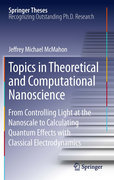
Topics in theoretical and computational nanoscience: from controlling light at the nanoscale to calculating quantum effects with classical electrodynamics
McMahon, Jeffrey Michael
Interest in structures with nanometer-length features has significantly increased as experimental techniques for their fabrication have become possible. The study of phenomena in this area is termed nanoscience, and is a research focus of chemists, pure and applied physics, electrical engineers, and others. The reason for such a focus is the wide range of novel effects that exist at this scale, both of fundamental and practical interest, which often arise from the interaction between metallic nanostructures and light, and range from large electromagnetic field enhancements to extraordinary optical transmission of light through arrays of subwavelength holes.This dissertation is aimed at addressing some of the most fundamental and outstanding questions in nanoscience from a theoretical and computational perspective, specifically:At the single nanoparticle level, how well do experimental and classical electrodynamics agree? What is the detailed relationship between optical response and nanoparticle morphology, composition, and environment? Does an optimal nanostructure exist for generating large electromagnetic field enhancements, and is there a fundamental limit to this?Can nanostructures be used to control light, such as confining it, or causing fundamentally different scattering phenomena to interact, such as electromagnetic surface modes and diffraction effects? Is it possible tocalculate quantum effects using classical electrodynamics, and if so, how do they affect optical properties? Prize-awarded thesisNew research in an emerging fieldInterdisciplinary applications for chemistry, physics, and materials science INDICE: INTRODUCTION. BASIC ELECTROMAGNETIC THEORY. THEORETICAL AND COMPUTATIONAL METHODS. CORRELATED SINGLE-NANOPARTICLE CALCULATIONS AND MEASUREMENTS.OPTIMAL SERS NANOSTRUCTURES. NANOSTRUCTURED METAL FILMS. OPTICAL CORRALS. CONCLUSIONS AND OUTLOOK. DRUDE PLUS TWO LORENTZ POLE (D2L) DIELECTRIC MODEL PARAMETERS. DERIVATION OF THE FINITE-ELEMENT FUNCTIONAL. DERIVATION OF THE HYDRODYNAMIC DRUDE MODEL. DERIVATION OF NONLOCAL FINITE-DIFFERENCE EQUATIONS.-
- ISBN: 978-1-4419-8248-3
- Editorial: Springer
- Encuadernacion: Cartoné
- Páginas: 250
- Fecha Publicación: 29/03/2011
- Nº Volúmenes: 1
- Idioma: Inglés
